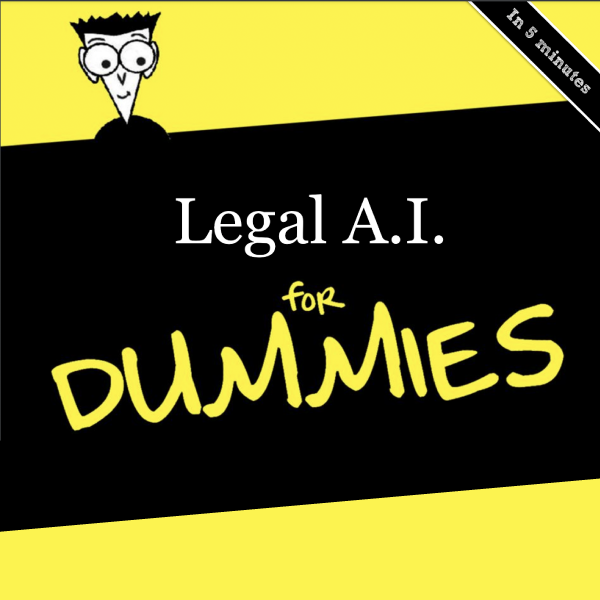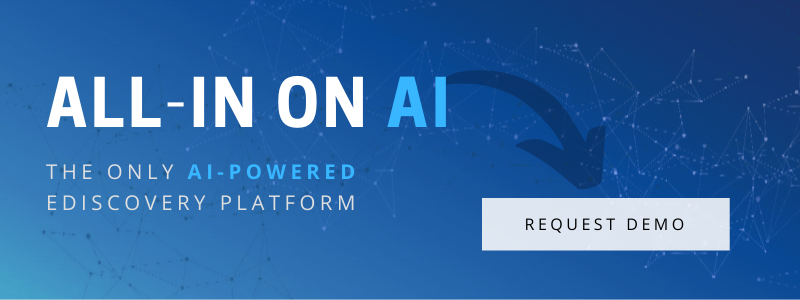Legal AI for Dummies: A simplified look at AI for Law
While the spectre of Robo-lawyer overlords displacing legal practitioners, leaving a herd of people in threadbare Brooks Brothers suits holding signs that say “will litigate for food” in their wake is an apocalyptic nightmare some have, but this fantasy is best left to Hollywood blockbusters. Unfortunately, there really is quite a bit of “fear, uncertainty and doubt” (FUD) floating around the legal industry about what the heck Artificial Intelligence (AI) actually is and how it should be integrated into the practice of law without putting everyone out of work. So, let's ditch the FUD and reveal what AI can truly do and how it can help you supercharge your legal practice.
What the heck is Artificial Intelligence (AI)?
The grandfather of modern AI, John McCarthy, originally conceived of what he called the “science and engineering of making intelligent machines.” McCarthy first discussed this novel concept over 60 years ago, and had a vision that “every aspect of learning or any other feature of intelligence” could be replicated by a machine. Quite literally, he saw a future where machines can and will do anything a human can do.
Thankfully, autonomous cyborgs are far from replacing the uniquely human aspects of critical reasoning and perception. Over the decades, computer scientists realized that many skills like critical reasoning and problem solving are better approached by humans using advanced technology and data science than by machines alone. The strategic advantage humans have in these areas mean that it is better to farm out lower value tasks, which can be performed by machines, and leave the more complicated mental gymnastics to the living legal brain that is still the supreme champion of data processing.
A recent article coined a more modern conception of AI focuses on a system’s ability to “correctly interpret external data, to learn from such data, and to use those learnings to achieve specific goals and tasks through flexible adaptation.” Reworded into a simple question: Can a system learn from human or data inputs and perform a job or provide an insight as a result?
What About AI in the Legal Profession?
While some industries have been leveraging the benefits of AI for decades, legal has taken a more cautious approach, only recently incorporating AI to quickly surface key information or automate low value or repetitive tasks. In the context of the practice of law, legal research and eDiscovery in particular, the deployment of AI has generally fallen into the category of machine learning.
As the name implies, machine learning is a subset of AI characterized by the use of algorithms and statistical methods to enable machines to improve or learn through experience. Broadly speaking, most legal AI tools today rely on algorithms trained with human input to identify similar or dissimilar categories of documents to reduce the amount of time it takes to surface key concepts or evidence.
- Supervised machine learning: Algorithms learn from human input and labeling within the dataset at the outset (training in TAR 1.0).
- Unsupervised learning: Algorithms make inferences about a data set without human input (Brainspace’s concept clustering, concept categorization, and social network analysis).
- Reinforcement learning: Algorithms continue to learn from human input in an ongoing way, getting “smarter” over time (TAR 2.0, Reveal AI).
Source: LawGeex
Legal AI in Action
There is a wide array of AI applications in law today. From AI-powered evidence retrieval to portable AI modeling and even smart billing, it seems like new technology is bleeding into nearly every aspect of legal services and the practice of law — because it is!
eDiscovery
One of the earliest expressions of AI for law, eDiscovery leverages deep learning and AI systems to parse large volumes of data and extract insights more quickly. Technology like Brainspace and Reveal AI capitalize on a combination of supervised, unsupervised, and reinforcement learning to provide legal professionals with key evidence and insights in a fraction of the time:
- Social Network Analysis: automatically surfaces communication patterns like who is speaking to who and with what frequency.
- Concept Clustering: Automatically visualizes data analytics and key concepts to accelerate matter understanding and prioritization.
- Technology Assisted Review: the AI learns from each coding decision then amplifies it across the data set and surfaces similar legal documents to dramatically accelerate document review speeds.
- BERT powered AI Model Sharing: Industry leading AI builds a library of shareable and reusable models to help pre-train the technology to surface the information you need for your matter.
- Sentiment and Context Analysis: Uncovers hidden connections between people, places, and things to give you better insights into your data and case.
Contracts
The use of AI can exist throughout contract lifecycle management including: clause extraction and anomaly detection, contract review, and due diligence. There are even smart contracts that reside on blockchain with automatic execution based on certain parameters. From inception through execution and lifecycle management AI is helping to automate repetitive tasks and create more consistency for organizations across a portfolio of contracts.
The Contract Analytics technology today is centralized around two main AI deployments:
-
Document/Contract Automation: Machine learning automated document or contract drafting based on a human generated taxonomy. A standardized and automated method for executing routine document tasks (approvals, assignments, requests, signatures, and claims), generation of documents and contracts, and updating the knowledge and copy within the document set. Often combined with a digital document repository, this technology serves as a single place to create, manage, and even execute documents without manual involvement. The pandemic has dramatically accelerated this area of legal tech.
-
Anomaly Detection: AI deployed to analyze, identify, or categorize clauses in an effort to create more control and reduce anomalous clauses.
Matter Management
As clients have become more sophisticated, they are demanding more data-driven decision-making from their outside counsel. As a result, there is a big focus on leveraging machine learning or AI to gain aggregate insights across a full portfolio of cases. Case management software serves as a single repository that enables practitioners to manage, store, and track legal cases and records like contacts, intakes, documents, events, tasks, and more. Well deployed matter management systems optimize case intake, provide actionable data-driven insights about resourcing and tasks and even AI powered invoice generation and approval.
Practice Management
Project Management software using AI can take case management solutions and data driven insights to the next level by helping clients manage important deadlines, manage client cases and documents, bill clients, and accept payments relating to their legal needs. With the aim of helping law firms and legal departments manage the business of being a law firm, their functionality spans a multitude of areas including case & client records, bookkeeping, billing, schedules, appointments, and more. More sophisticated platforms are leveraging machine learning and AI to extract business intelligence around billing and capex as well as to uncover ways to optimize the practice as a whole.
Source:
Knowledge Management
The holy grail of knowledge management is the ability to extract key pieces of information from the minds of lawyers and case teams in a searchable format that is accessible firmwide independent of any individual legal practitioner. From preserving and sharing institutional knowledge to ensuring the right talent is tapped for a given matter, the potential value of this AI powered offering is material.
Outcome Prediction
Some practitioners are using AI powered insights from past matters to inform settlement discussions or funding analysis on current cases. In this fascinating emerging area of legal technology, AI software generates predictive results that forecast case outcomes based on various data inputs from past matters. Various AI tools on the market aggregate court decisions at the state or federal level to make predictions of rulings based on specific fact patterns, judges, or districts.
Legal AI and you
Both savvy firms and startups are doubling down on integrating AI technology across their organizations to differentiate themselves and gain a competitive advantage over the competition. Practitioners that embrace these emerging technologies are able to dramatically accelerate their career trajectory. The first step in embracing the AI powered future of the legal sector is to educate yourself beyond what you may have learned in law school. I recommend that you seek out insights from a resident data dork (like myself), read the technology rags, or reach out to your technology partners to begin. Start the journey now, because the paths between those who are embracing tech and those who are failing to do so have already begun to diverge, and the former are the clear victors.


